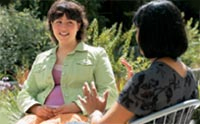Teens Do Better Here
Higher cure rates and fewer long-term effects from treatment are just two of the benefits teenagers and young adults up to age 21 receive when their cancer is treated at pediatric medical centers.
Mary Elizabeth’s Story

Mary Elizabeth Sierra-Lanham, 14, chatting with social worker Tonya Ranchigoda, says she appreciates staff members’ ability to relate to teens.
When Mary Elizabeth Sierra-Lanham had her eyes checked for nearsightedness, the routine exam showed that the optic nerve in her right eye was swollen. A string of visits to different specialists led to an MRI that finally explained the problem – a lump in her head was pressing against a major vein.
That was when mom Sally Lanham brought Mary Elizabeth to Seattle Children’s, where blood and bone marrow samples confirmed that her daughter had acute lymphoblastic leukemia (ALL), a type of cancer where malignant white blood cells or “lymphoblasts” are overproduced in the bone marrow and can spread into the bloodstream and vital organs. ALL accounts for approximately 25% of all childhood cancer.
Although Lanham didn’t know it when she switched Mary Elizabeth’s care to Seattle Children’s, her decision may have saved her daughter’s life: Teenagers and young adults have a much better chance of beating ALL – more than 25% better – when they receive pediatric cancer treatments rather than those intended for adults. Separate studies in North America, France, the Netherlands and Italy confirm these findings.
“We’ve learned from years of research that teenagers have far fewer relapses when their treatment is longer and more aggressive than the less rigorous treatment that middle-agers and seniors receive,” says pediatric oncologist Dr. Doug Hawkins.
“Yet, we still see medical oncologists out in the community treating 15-to-21-year-olds with less effective protocols that are sometimes decades out of date.”
At Children’s, teens and young adults with cancer not only benefit from cancer treatments developed specifically for their age group, they also thrive in an environment where teams of skilled providers focus on their long-term health concerns and the unique needs of their entire family.
Mary Elizabeth recalls the MRI technician who played music and chatted with her during her first procedure at Seattle Children’s – the visit that confirmed her cancer diagnosis.
“I had an MRI at another hospital and it was scary,” says Mary Elizabeth. “They left me alone and no one checked on me. At Seattle Children’s, the staff tell stories and we laugh. I’ll miss them when I’m done with treatment.”